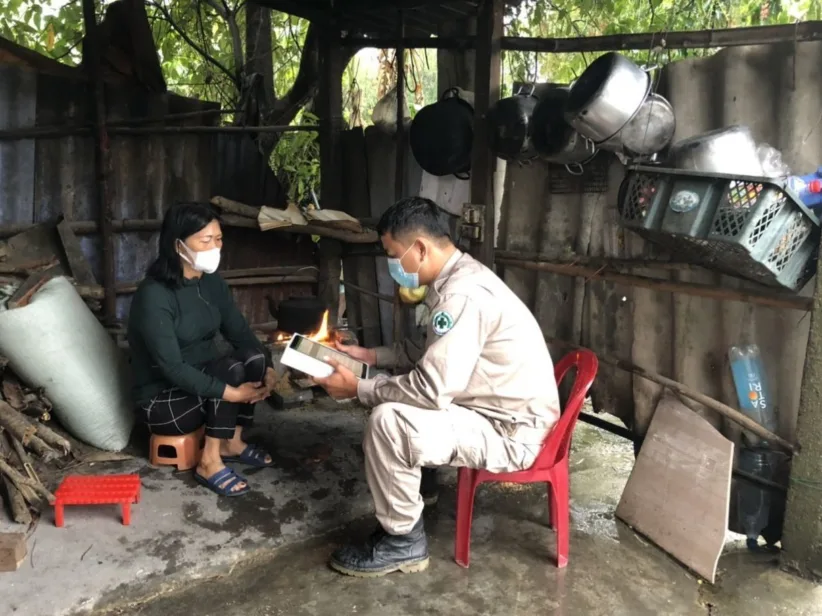Analysing soil in order to detect pollution from ageing explosives in Vietnam
The mine action sector is becoming increasingly more focused on the links between mine action and environmental protection. In Vietnam, this has resulted in a pilot project that investigates the link between ageing munitions and agricultural soil pollution.
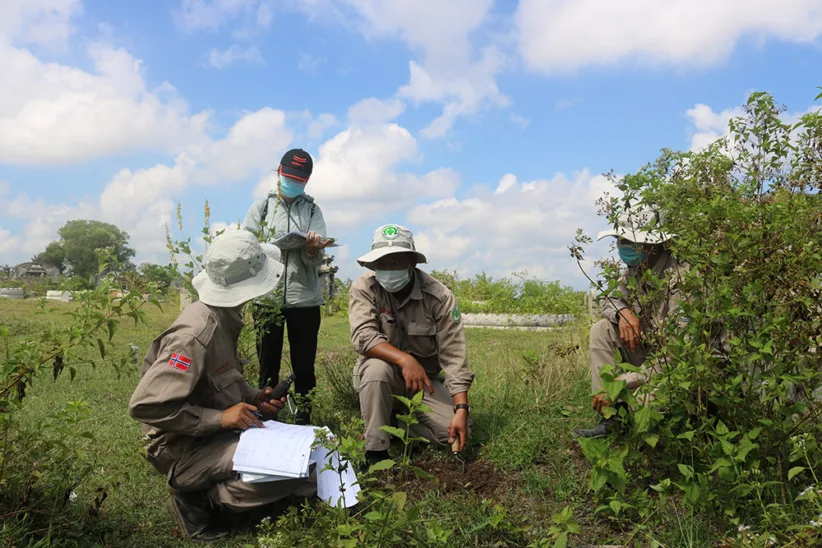
“To us, the presence of explosive ordnance means pollution to the environment,” says Mr Nguyen Kinh, Head of Commune of Luong Mai village, Thua Thien Hue province, Vietnam.
To us, the presence of explosive ordnance means pollution to the environment
As the mine action sector – donors, operators, authorities and local beneficiary communities alike – increase focus on the links between mine action and environmental protection, NPA Vietnam is seeking to answer one key question: do ageing munitions in Vietnam pose a significant threat to the environment as they degrade, by contaminating agricultural soil with heavy metals or other chemicals?
Most unexploded bombs in Vietnam remain after conflicts during the 1960s and 1970s, with potentially millions of items lying in the soil for up to 60 years. “Bombs and explosives lying in the ground for a long time can cause heavy impacts on the soil,” Mr Le Dinh Phong, NPA Provincial Operations Manager in Thua Thien Hue, says. “This is due to the oxidation of metals from the shells of explosives, changes in soil substances, and pollution of heavy metals such as iron, copper, aluminum and explosive components.”
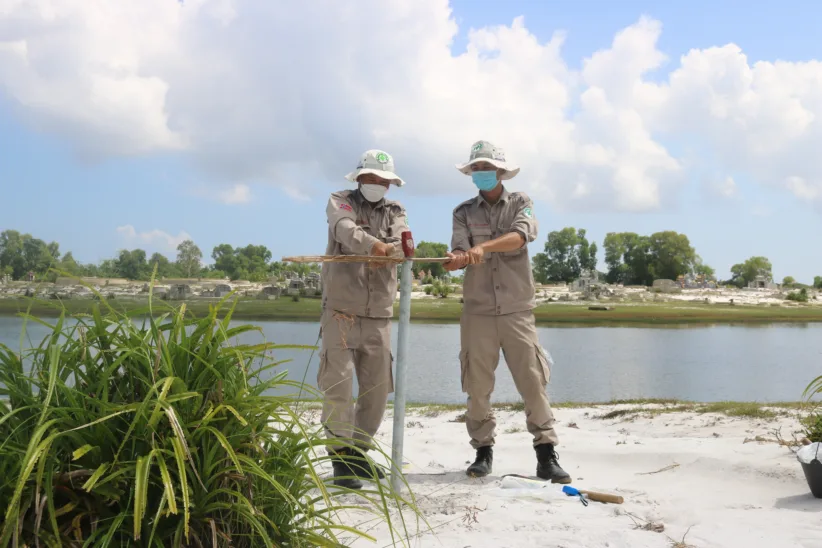
Bombs and explosives lying in the ground for a long time can cause heavy impacts on the soil
While some studies indicate a high concentration of toxic elements have been found in military-impacted zones, limited work has been done in Vietnam to specifically look at the potential impacts of heavy metals or chemicals from aged munitions impacting the surrounding environment.
In a pilot project currently being conducted in Thua Thien Hue province in Central Vietnam, NPA has trained experienced non-technical survey (NTS) team members to collect soil samples from areas with known contamination from explosive ordnance, and are working with a local university to test these samples for potential heavy metal residue from explosives.
Dr Ho Dac Thai Hoang is the Director of the Institute of Resources and Environment (IREN) at Hue University, and oversees the laboratory where soil samples are tested for heavy metal contamination. He says the need to assess the heavy metal residue and leakage of explosive materials from war remnants is gradually being noticed as agricultural pressures, and particularly the demand for organic products, rise. However, knowledge on the actual impacts of soil contamination from explosive ordnance is lacking.
“There are still no continuous and seamless studies [of soil contamination from explosive ordnance] in Hue,” Dr Hoang says. “Only intermittent and qualitative rather than quantitative studies are organized, but hopefully, in the future, the research will receive more attention to better suit the needs of farmers, landowners, and producers.”
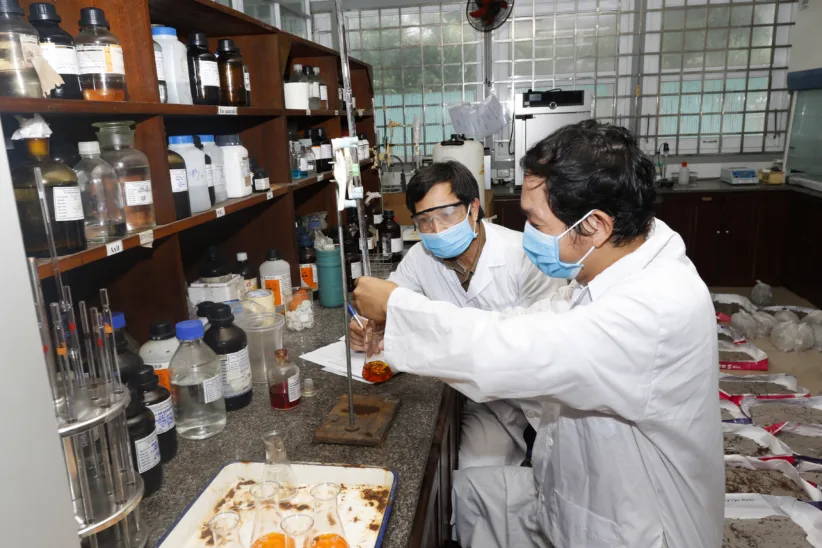
While NPA awaits the completion of the laboratory work on soil samples – expected by early 2022 – there is an overwhelming amount of qualitative evidence indicating that corroding explosive ordnance may be having a negative impact on the environment.
I have seen that plants and bushes grow poorly in areas with explosive ordnance compared to other places
“I have seen that plants and bushes grow poorly in areas with explosive ordnance compared to other places,” said Mr Nguyen Thanh Tuan, one of the land owners who had soil samples collected from his farmland in Luong Mai village. “Crops also grow slowly with low yield, while other places seem much better.”
Mr Vo Linh Vu, Head of Luong Mai village, shared similar concerns. “Many areas with explosive ordnance are abandoned. Many places have substances that have leaked from ordnance, causing weeds to burn. There are many places where trees can’t grow, some with dense primary forest nearby,” Mr Vo said. “Environmental pollution due to toxic substances, including heavy metals from bombs and mines, has affected the health, life and income of people. People just want a safe environment to live and cultivate their land.”
Environmental pollution due to toxic substances, including heavy metals from bombs and mines, has affected the health, life and income of people. People just want a safe environment to live and cultivate their land
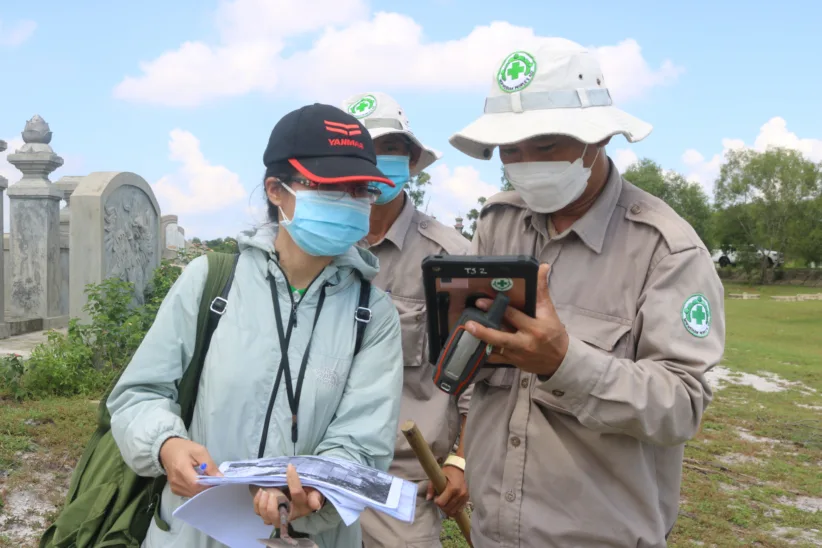
NPA’s experienced staff in Thua Thien Hue province have also noticed potential links during mine action activities. Tran Hong Phuong, team leader of one NTS team conducting soil sampling, remembers a village in A Luoi district along Hue’s mountainous border with Lao PDR. “After the war ended, in this area, the water and soil were contaminated with a large amount of toxic chemicals, making the water and land unusable,” he recalls.
To conduct the soil sampling, two of NPA’s experienced NTS teams were trained to collect soil samples in an area previously confirmed to be contaminated with explosive ordnance through NPA’s routine mine action activities. Six personnel were trained to identify sample locations using existing NPA information management tools used during NTS, and collect and label soil samples taken from different depths at a given GPS location. The methodology is quick to learn and implement, making it easy to replicate in other areas if this pilot project is a success.
After the war ended, in this area, the water and soil were contaminated with a large amount of toxic chemicals, making the water and land unusable
Le Dinh Phong welcomes the additional focus on environment. “This is part of the organization’s post-clearance impact assessment, helping to guide and support be people to achieve high results and stronger economies than before,” Phong said.
“I feel a sense of pride when doing this meaningful activity,” says NTS leader Tran Hong Phuong. His colleague Le Thai Anh, leader of the second NTS team piloting the soil sampling methodology, agrees. “It is very convenient and suitable to include in NTS work because this work is based on approaching and collecting information directly from the people.”
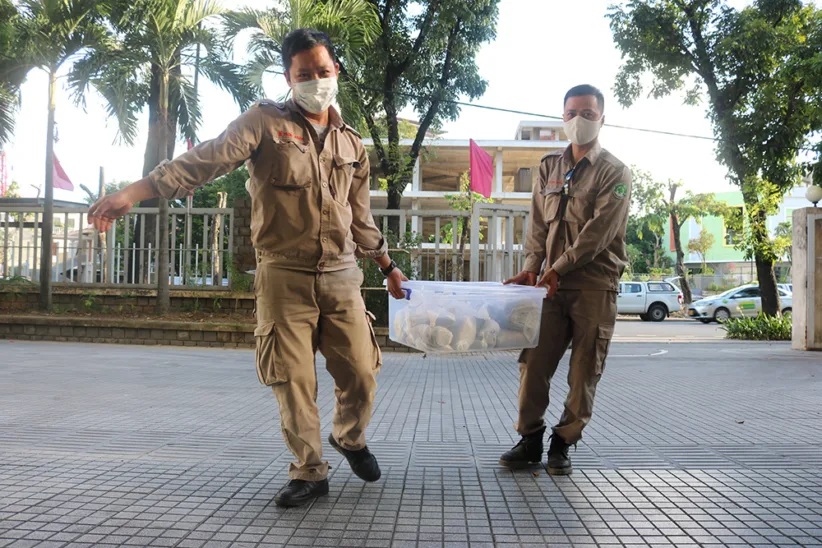
I feel a sense of pride when doing this meaningful activity
Following the collection of samples, the soil is transported to IREN’s laboratory in Hue city to undergo testing for a number of heavy metals. A total of 64 soil samples from Luong Mai village will be tested. At the same time, testing on the nutrient properties of the soil will also be conducted, and NPA’s NTS personnel will interview people from 100 households in Luong Mai village to understand the needs and current practices of land use in the village, specifically relating to the use of land and agricultural opportunities and setbacks in the area where soil samples were collected.
This information, combined with the laboratory results, will help inform a realistic recommendation for optimising land use and promoting sustainable land management. The results of the project will be shared with Luong Mai village and specifically the land owners, through a number of reports, digital soil maps and community training sessions.
If the area is polluted, I will still cultivate because of economic difficulties. I have no other choice. I really want to clean up the pollution so that I can cultivate and expand production with peace of mind. But I do not know where to look for help.
The land where soil samples were collected will be used primarily for seasonal crops including peanuts, cassava and yams; low-value forestry such as acacia trees; and grazing livestock and poultry. “If the area is polluted, I will still cultivate because of economic difficulties,” says Mr Vo Linh Vu. “I have no other choice. I really want to clean up the pollution so that I can cultivate and expand production with peace of mind. But I do not know where to look for help.”
“We will propose solutions to fix residues through the use of corresponding flora to store pollutants, structural solutions or other neutralization solutions,” said Dr Hoang. “We prefer an environmentally friendly method by immobilizing residues on plants with long and perennial lifespans.”
“It is very necessary for the community to have knowledge about the current situation, and advice on suitable livestock and plants to bring higher income for local people… Continued contamination will not be beneficial to people or the environment,” says Mr Nguyen Kinh, Head of Commune of Luong Mai village. “This is a legacy of war that people living here are still being affected by.”
This is a legacy of war that people living here are still being affected by
